
Vitreous enamel, also called porcelain enamel, is a material made by fusing powdered glass to a substrate by firing, usually between 750 and 850 °C. The powder melts, flows, and then hardens to a smooth, durable vitreous coating. The word comes from the Latin vitreum, meaning "glass".

The Alfred Jewel is a piece of Anglo-Saxon goldsmithing work made of enamel and quartz enclosed in gold. It was discovered in 1693, in North Petherton, Somerset, England and is now one of the most popular exhibits at the Ashmolean Museum in Oxford. It has been dated to the late 9th century, in the reign of Alfred the Great, and is inscribed "AELFRED MEC HEHT GEWYRCAN", meaning "Alfred ordered me made". The jewel was once attached to a rod, probably of wood, at its base. After decades of scholarly discussion, it is now "generally accepted" that the jewel's function was to be the handle for a pointer stick for following words when reading a book. It is an exceptional and unusual example of Anglo-Saxon jewellery.

Cloisonné is an ancient technique for decorating metalwork objects with colored material held in place or separated by metal strips or wire, normally of gold. In recent centuries, vitreous enamel has been used, but inlays of cut gemstones, glass and other materials were also used during older periods; indeed cloisonné enamel very probably began as an easier imitation of cloisonné work using gems. The resulting objects can also be called cloisonné. The decoration is formed by first adding compartments to the metal object by soldering or affixing silver or gold as wires or thin strips placed on their edges. These remain visible in the finished piece, separating the different compartments of the enamel or inlays, which are often of several colors. Cloisonné enamel objects are worked on with enamel powder made into a paste, which then needs to be fired in a kiln. If gemstones or colored glass are used, the pieces need to be cut or ground into the shape of each cloison.

The Abbey of St Mary is a ruined Benedictine abbey in York, England and a scheduled monument.
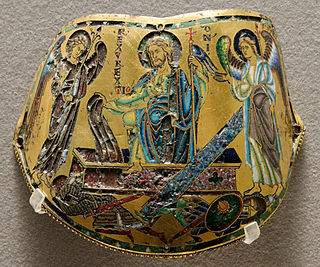
Champlevé is an enamelling technique in the decorative arts, or an object made by that process, in which troughs or cells are carved, etched, die struck, or cast into the surface of a metal object, and filled with vitreous enamel. The piece is then fired until the enamel fuses, and when cooled the surface of the object is polished. The uncarved portions of the original surface remain visible as a frame for the enamel designs; typically they are gilded in medieval work. The name comes from the French for "raised field", "field" meaning background, though the technique in practice lowers the area to be enamelled rather than raising the rest of the surface.

Castello Ursino, also known as Castello Svevo di Catania, is a castle in Catania, Sicily, southern Italy. It was built in the 13th century as a royal castle of the Kingdom of Sicily, and is mostly known for its role in the Sicilian Vespers, when it became the seat of the Sicilian Parliament. The castle is in good condition today, and it is open to the public as a museum.

Nicholas of Verdun was a renowned metalworker, goldsmith and enamellist active around the years 1180–1205. He was born in the city of Verdun, Upper Lorraine. The region extending from the valley of the Rhine and Meuse rivers to Cologne was the major northern center of copperplate enameled metalwork in the 12th century and Nicholas was probably trained in one of the many Mosan workshops. Although he must have maintained a large atelier of his own with numerous assistants, possibly based in Verdun, commissions in Cologne, northern France and outside Vienna required him to travel frequently.
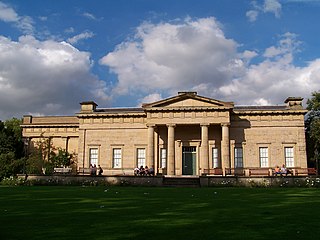
The Yorkshire Museum is a museum in York, England. It was opened in 1830, and has five permanent collections, covering biology, geology, archaeology, numismatics and astronomy.
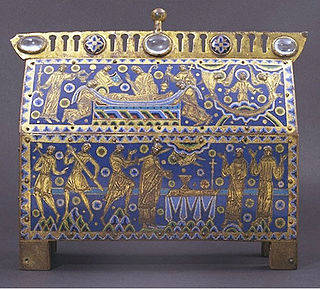
The Becket Casket is a reliquary in Limoges enamel now in the Victoria and Albert Museum. It is made of gilt-copper round a wooden core, decorated with champlevé enamel, and of a shape called a "chasse". It was made in about 1180–90 in Limoges, France, and depicts one of the most infamous events in English history. On the night of 29 December 1170, Archbishop Thomas Becket was murdered in Canterbury cathedral by four knights obeying the wishes of King Henry II. It provoked outrage throughout Europe, and pilgrims flocked to Canterbury to pray at the site of the murder. In 1173 Becket was canonized and his shrine was one of the most famous in the Christian world, until its total destruction in 1538 during the reign of Henry VIII. It is thought that this particular casket was made to hold the relics of Thomas Becket that were taken to Peterborough Abbey by Abbot Benedict in 1177. Benedict had been Prior at Canterbury Cathedral and therefore saw Becket's assassination.

Limoges enamel has been produced at Limoges, in south-western France, over several centuries up to the present. There are two periods when it was of European importance. From the 12th century to 1370 there was a large industry producing metal objects decorated in enamel using the champlevé technique, of which most of the survivals, and probably most of the original production, are religious objects such as reliquaries.

The Ormside Bowl is an Anglo-Saxon double-bowl in gilded silver and bronze, with glass, perhaps Northumbrian, dating from the mid-8th century which was found in 1823, possibly buried next to a Viking warrior in Great Ormside, Cumbria, though the circumstances of the find were not well recorded. If so, the bowl was probably looted from York by the warrior before being buried with him on his death. The bowl is one of the finest pieces of Anglo-Saxon silverwork found in England.

A chasse, châsse or box reliquary is a shape commonly used in medieval metalwork for reliquaries and other containers. To the modern eye the form resembles a house, though a tomb or church was more the intention, with an oblong base, straight sides and two sloping top faces meeting at a central ridge, often marked by a raised strip and decoration. From the sides there are therefore triangular "gable" areas.
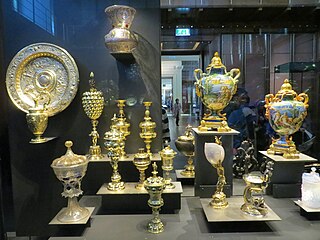
In 1898, Baron Ferdinand de Rothschild bequeathed to the British Museum as the Waddesdon Bequest the contents from his New Smoking Room at Waddesdon Manor. This consisted of a wide-ranging collection of almost 300 objets d'art et de vertu, which included exquisite examples of jewellery, plate, enamel, carvings, glass and maiolica. One of the earlier objects is the outstanding Holy Thorn Reliquary, probably created in the 1390s in Paris for John, Duke of Berry. The collection is in the tradition of a schatzkammer, or treasure house, such as those formed by the Renaissance princes of Europe; indeed, the majority of the objects are from late Renaissance Europe, although there are several important medieval pieces, and outliers from classical antiquity and medieval Syria.

Edmund Robert Anthony de Unger was a Hungarian-born property developer and art collector. In London he built up the Keir Collection, one of the greatest post-war collections of Islamic art, bequeathed in 2008 to the Pergamon Museum of Islamic Art in Berlin. The arrangement for the museum to curate the collection came to an end in July 2012. The collection is now hosted by the Dallas Museum of Art as of May 2014 for a 15-year renewable loan.

The Trier Cathedral Treasury is a museum of Christian art and medieval art in Trier, Germany. The museum is owned by the Roman Catholic Diocese of Trier and is located inside the Cathedral of Trier. It contains some of the church's most valuable relics, reliquaries, liturgical vessels, ivories, manuscripts and other artistic objects. The history of the Trier church treasure goes back at least 800 years. In spite of heavy losses during the period of the Coalition Wars, it is one of the richest cathedral treasuries in Germany. With the cathedral it forms part of a UNESCO World Heritage Site.

Anglo-Saxon brooches are a large group of decorative brooches found in England from the fifth to the eleventh centuries. In the early Anglo-Saxon era, there were two main categories of brooch: the long (bow) brooch and the circular (disc) brooch. The long brooch category includes cruciform, square-headed, radiate-headed, and small-long brooch brooches. The long brooches went out of fashion by the end of the sixth century.
Jennifer Foster is an English scholar of prehistoric and medieval archaeology, who specializes in the study of artifacts, particularly metalwork.

The Spitzer Cross is an enameled metal crucifix, made c.1190 in Limoges, in France, by an artisan known as the "Master of the Royal Plantagenet Workshop", and now held by the Cleveland Museum of Art. The work is made from copper, engraved and gilded, and inlaid with champlevé Limoges enamel, depicting Christ on the cross in tones of blue, green, yellow, red and white. It may have been made as a processional cross for the Abbey of Grandmont: similar Limoges enamel crosses are held in other public collections, including the Metropolitan Museum of Art and the British Museum.
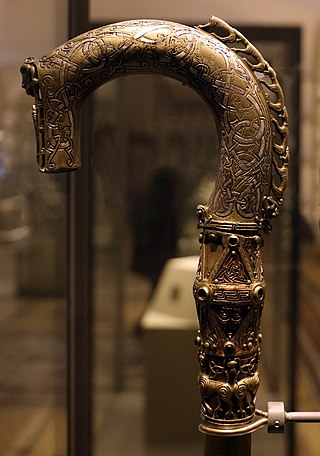
The Clonmacnoise Crozier is a late-11th-century Insular crozier that would have been used as a ceremonial staff for bishops and mitred abbots. Its origins and medieval provenance are unknown. It was likely discovered in the late 18th or early 19th century in the monastery of Clonmacnoise in County Offaly, Ireland. The crozier has two main parts: a long shaft and a curved crook. Its style reflects elements of Viking art, especially the snake-like animals in figure-of-eight patterns running on the sides of the body of the crook, and the ribbon of dog-like animals in openwork that form the crest at its top. Apart from a shortening to the staff length and the loss of some inserted gems, it is largely intact and is one of the best-preserved surviving pieces of Insular metalwork.

The Ryedale Roman Bronzes is an assemblage of Roman metalwork.



















